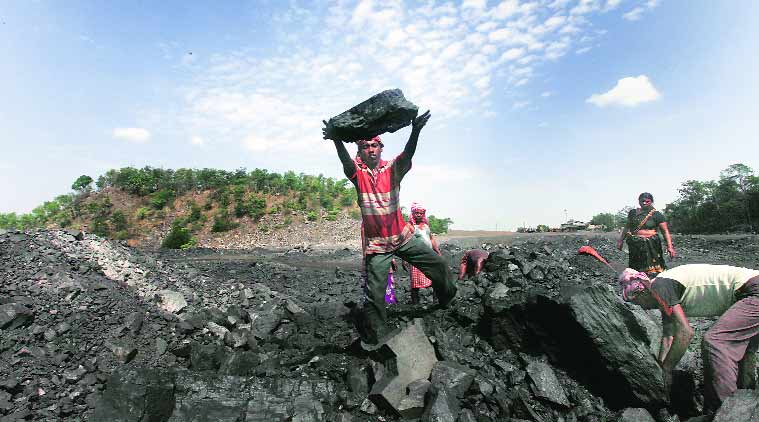- India
- International
Staying away from fire
The Centre plans to resettle over 1 lakh people away from the burning coal mines of Jharia in Jharkhand, but for many, the rehabilitation has brought with it a new set of worries.
 With 1,000 ‘encroacher’ families being shifted away from the mines, they wonder how they will make a living. (Source: Express Photo by Partha Paul)
With 1,000 ‘encroacher’ families being shifted away from the mines, they wonder how they will make a living. (Source: Express Photo by Partha Paul)
Rajiv Bhuiyan, 9, loves playing football. But his playground is a minefield, quite literally. As a resident of Ghannudi slum in Jharia, a mining town of about 7 lakh people in Dhanbad district of Jharkhand, Rajiv has seen an underground fire eating away his home. Cracks spurting harmful gases divide his house into two parts — the habitable and the uninhabitable. The living room of his tiny two-room house is where they cook now, the other room is in the danger zone. At night, the rooms turn into ovens and Rajiv and his family sleep outdoors. “The ground is so hot that my slippers melt,” he says.
Last month, Prime Minister Narendra Modi said he was determined to move over 100,000 people living near coal fields in Jharkhand to new homes, so that it is easier to douse underground fires and mine huge reserves of premium coal. In February this year, when the PM visited Jharkhand, he reportedly urged Chief Minister Raghubar Das to speed up the rehabilitation process.
“In the last few months, we have had government people doing surveys and telling us we will be shifted soon. I will be shifted to a two-bedroom flat at Belgaria rehabilitation colony within next week,” says Mohan Singh, 36, a building contractor who owns a two-storeyed house in the affected area.
It’s difficult to walk around Jharia without thick-soled shoes. The air shimmers with heat and gaping cracks glow with blue-hued fire, plumes of sulphurous smoke coming out of them. To most people here, the cracks are simply fatelines. Kaushalya Devi, 30, who has lost half her house to the fire, says she is always worried for her four-year-old. “She might fall into a crack any moment. Or topple over the ravine,” she says.
The first coal mine fire in Jharia was reported in 1916. Ashok Agarwal of Jharia Coalfield Bachao Samiti says that before coal assets were nationalised in 1972, mining companies “carelessly” left the mines open after digging, thus exposing the coal to open air. This resulted in spontaneous combustion. “Bharat Coking Coal Limited (BCCL) indulged in it blatantly to extract faster and cheaper coal, now we are paying for it,” says Agarwal.

In the last four years, about a 100 fires have been reported from around Jharia’s coal fields. With over 4,000 people per square km, Jharia, says Raju EVR, BCCL deputy manager, is “the most densely populated mining area in the world”. Deep ravines of open-cast mines are dug out overnight next to dwellings, women walk down long stretches of roads with bundles of pilfered coal on their heads to be sold to black marketeers in Dhanbad and Jharia, and trees are laden with black dust.
For years, the BCCL has tried different ways to douse the fires, with little luck. “Earlier, we tried sealing the surface, trenching and pumping in inert gases to control the fire. But this method proved expensive and was hardly successful,” says BCCL MDT K Lahiri. Since taking charge in 2008, Lahiri’s team started a new way of keeping the fire in check: dig deeper and wider to remove burning coal.
As fires eat away the land, three categories of people need rehab — BCCL employees, private land owners, and those who didn’t own any land — the third lot mostly people from neighbouring villages whom the BCCL calls ‘encroachers’. The ‘encroachers’ are a key part of the mining economy, working as loaders, sorters and traders who own shops around the mines. Of the 15,000 BCCL workers in need of rehabilitation, 2,500 have been shifted to a housing complex built by BCCL. The rehabilitation of the 1,30,000 ‘encroachers’ and private land owners, however, is what has been lagging. This task lies with the Jharia Rehabilitation and Development Authority (JRDA), a body floated by the government and BCCL. The agency claims BCCL has “not given adequate land to it to build housing colonies”. It is also still sorting out “confusion” over the amount of compensation to be given to the affected families. The amount varies, and averages, says Kripa Nand Jha of JRDA, at Rs 50,000.
In the last few months, about 1,000 ‘encroacher’ families have moved to two-bedroom flats away from the mines and hundreds of acres have been bought for more houses.
Belgaria, a housing colony built by BCCL and JRDA, is an island of yellow four-storied buildings 22 km from Jharia town and and 6 km from Dhanbad. Some 3,500 families live here — the BCCL workers in the better, bigger quarters, and the ‘enroachers’ in the smaller ones. The only way they can visit the nearest city is on a state transport bus that comes this way twice a day.
When Dinanath Singh, 50, shifted to Belgaria from Ghannudi settlement in Jharia about two years ago, there were no hospitals, schools or shops. “Things are marginally better now. The power supply in my part of the colony has stabilised. But there is no medical centre yet. We have to rush to Jharia or Dhanbad in an emergency,” says Singh.
A group of young men have gathered around a cigarette shop. “What do we do without the mines,” says Suraj Singh, 20, whose father Manohar Singh was a coal loader with BCCL.
Deepak Pandey, a local journalist, points out other affected areas where the government or BCCL has shown no interest. “There is no urgency to move people from areas like Pandeybera and Lodna Kujama because there is not much coal to be taken from there,” says Pandey.
Gopalji (who goes by his first name), resettlement officer of JRDA, says rehabilitation is being conducted according to a “priority list” made by BCCL.
In Pandeybera, a tiny hamlet near Kujama mines, the fire has been burning for years but no one’s heard about the relocation plan. Dhruba Devi, 36, has lived in the village since her wedding about a decade ago. She works as a coal-sorter and earns about Rs 150 a day. “I don’t want them to shift us somewhere else. Where will we go? What will we do? Can’t they simply douse the fire?” she asks.
Apr 23: Latest News
- 01
- 02
- 03
- 04
- 05






































